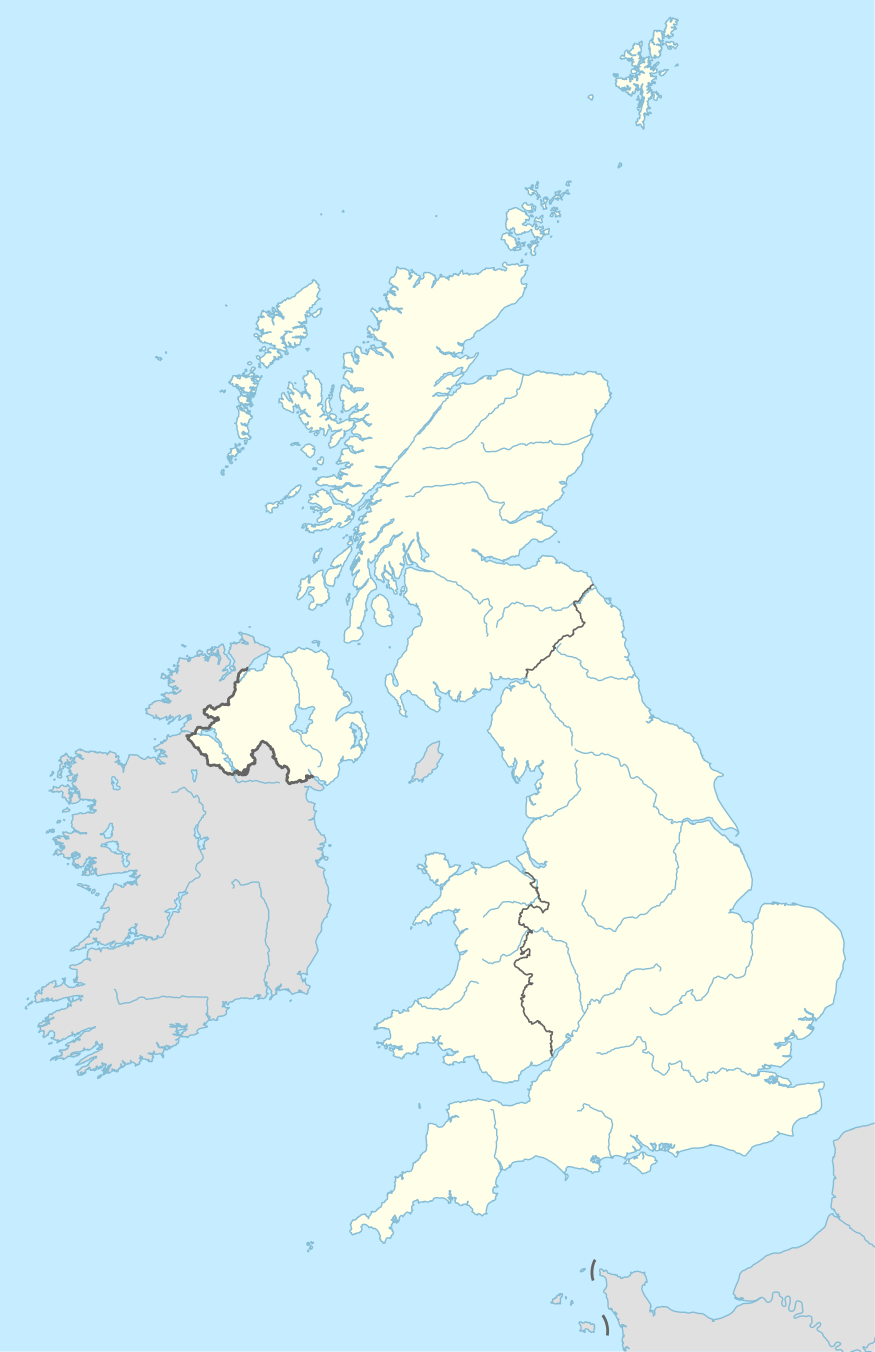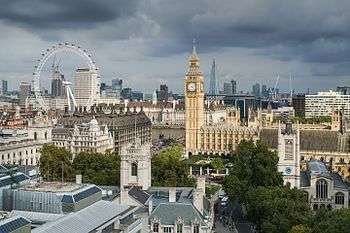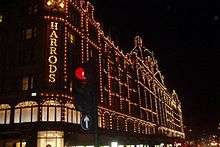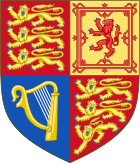Tourism in the United Kingdom
The United Kingdom is the world's 10th biggest tourist destination, with over 37 million visiting in 2018. The tourism industry contributed a total of £213 billion to the GDP in 2017, which is expected to increase to £265 billion by 2028.[2]
| Country | Number |
|---|---|
| United States | 3.87 million |
| France | 3.69 million |
| Germany | 3.26 million |
| Ireland | 2.78 million |
| Spain | 2.53 million |
| Netherlands | 1.95 million |
| Poland | 1.82 million |
| Italy | 1.81 million |
| Belgium | 1.12 million |
| Australia | 1.00 million |
US$31.93 billion was spent in the UK by foreign tourists in 2017. VisitBritain data shows that the USA remains the most valuable inbound market, with American visitors spending £2.1 billion in 2010.[3] Nevertheless, the number of travellers originating from Europe is much larger than those travelling from North America: 21.5 million compared to 3.5 million American/Canadian visitors.[4] After a 7-year rise, tourism to the United Kingdom declined sharply from 2017 to 2018.[5]
The country's principal tourist destinations are London, Edinburgh, Oxford, Cambridge, York, and Canterbury.[6] The United Kingdom hosts a total of 32 World Heritage sites, the 8th most in the world.[7] The Lonely Planet travel guide voted England number 2, after Bhutan, as one of the best countries to visit in 2020.[8] Some of the most popular cities include London, Edinburgh and Manchester and notable attractions include the Palace of Westminster, the London Eye and Edinburgh Castle.
Tourism is the fastest growing industry in the United Kingdom and it is expected to grow by 3.8% annually until 2025, 0.5% higher than the global average, and is responsible for 10% of all jobs.[9][10]
The United Kingdom is the 10th most visited country in the world and the 4th most visited country in Europe.[11][12] Overall Europe has a 40% market share of total global tourist visits worldwide, with the United Kingdom contributing heavily.[12]
History

Tourism first began to increase during the 17th century when wealthy Europeans would follow the ‘Grand Tour’ of Western Europe which traditionally started in the United Kingdom before travelling to Italy.[13] Throughout the industrial revolution, tourism continued to spike as people began to have more disposable income and technological advancements made transport more convenient and affordable. In 1841, Thomas Cook, founder of Thomas Cook & Son, took 500 passengers by train on a return trip from Leicester to Loughborough.[14] This was his first excursion and is seen as a significant milestone in the creation of the British tourism industry.[14] The world wars dampened the growth of the tourism sector, although after World War II the government began putting measures in place to increase tourism recognising its political and economic influence.[15] By 1987, the World Tourism Organization estimated 3.4% of the UK’s GDP came from tourism.[15] More recently, budget airlines and cheap accommodation has caused almost continuous year-on-year growth. In more recent times, terrorist attacks in the UK such as the 7/7 bombings in 2005 have an expected negative impact on the tourism industry. The Global Financial Crisis of 2008 caused three consecutive years of the number of visitors from overseas decreasing for the only period between 2002-2017.[16]
Politics
The Parliamentary Under Secretary of State for Arts, Heritage and Tourism is the minister with responsibility over tourism in the UK.[17]
Domestic tourism
Domestic tourism remains the biggest component of tourist spending in the UK, with 2008 expenditures totalling £21.9 billion, according to VisitBritain.[18] The national statistical agency also estimates that there were 126 million trips made in 2009.[18] The busiest period for domestic travel in the UK is during bank holidays and the summer months, with August being the busiest.
International tourism
The official statistics for the final quarter of 2019 have yet to been published, although in 2018 a total of 37.9 million people visited the UK from overseas and cumulatively spent £22.8 billion, making the average spend per visit £601.[19] Compared to 2017, there were 5.3% and 2.3% respective decreases in international visitors and spending.[19] This is the first time since 2009-10 that the number of visitors has dropped.[19] This has been attributed to the emergence of other countries, particularly in the Middle East and Asia, as tourist destinations as well as the geopolitical uncertainty that has manifested as a result of the Brexit 2016 referendum.[20]
Visa and Entry requirements

Visa requirements are different depending on the origin of the individual wishing to enter the United Kingdom.[21] Some individuals are entitled to enter the United Kingdom without a visa and have no restrictions on their length of stay, work policies or study policies. These groups are: British nationals, citizens of Commonwealth countries who have the right of abode, Irish citizens and until at least 31 December 2020, European Union citizens and citizens of EFTA member states.[21] There are 56 other countries and territories that can stay in the UK for up to 6 months. Nationals of other countries are required to hold a Standard Visitor visa, costing £95, to be able to visit for up to 6 months.[22] For more information see visa policy of the United Kingdom.
Major Attractions

London is the most visited city in the UK, but some of the smaller town and cities manage to attract a significant number of tourists.[23] Cities such as Manchester and Liverpool being in the top 5 most populous cities are expected to draw large numbers, however some smaller cities have major landmarks luring visitors.[24] An example of this are the university cities of Oxford and Cambridge, which despite their smaller population are known worldwide because of the Oxbridge universities’ legacies.[25]
VisitBritain, the tourist board of Great Britain analyses data from the Office for National Statistics look to estimate the number of visitors that attend each attraction.[26] This can be difficult for landmarks such as Buckingham Palace or the Palace of Westminster as many people visit the surrounding area without actually being admitted into the venue.[26]
Transport
Arriving in the United Kingdom
The United Kingdom only has one land border where Northern Ireland meets the Republic of Ireland.[27] This border is considered an open border due to the Common Travel Area arrangement and as a result is subject to minimal controls.[28] The lack of control at the border makes it difficult to estimate the number of visitors from the Republic of Ireland into Northern Ireland.[29] In 2018, the total number of international visits to the United Kingdom was 37.9 million.[30] Out of the 37.9 million visitors, 29.06 million arrived by aeroplane, 4.81 million by boat and 4.04 million crossed from France using the Channel Tunnel.[31]
Travelling within the United Kingdom
.jpg)
With 48% of tourists using intracity buses, tubes, trams and metro trains; they are by far the most popular methods of transport.[32] The next most common methods of transports are taxis and trains (outside town/city) with 27% and 23% respectively.[32] Trains are used to travel between cities significantly more than aeroplanes, with only 1% of international visitors flying domestically.[32] This has been attributed to the United Kingdom’s vast rail network being the most economical way to travel.[33] Despite Uber being in a legal battle to operate in London, the rise of Uber and other ride-sharing companies throughout the United Kingdom has led to them being used by 9% of international tourists and they are expected to further increase, reducing the market share of other methods of transport.[34]
Events, Festivals and Exhibitions
The United Kingdom plays host to a variety of events that attract both international and domestic tourists.[35] Some of the United Kingdom’s most famous festivals include Notting Hill Carnival, Glastonbury and the Edinburgh Fringe Festival.[36] These festivals not only hold cultural significance but are also a major economic component of the United Kingdom’s tourist industry, with Glastonbury alone contributing £100 million to the economy annually.[37] The beauty, real estate and arms industries are some of the many industries that hold trade shows and exhibitions year-round throughout the United Kingdom, with the majority being held in London or Birmingham. VisitBritain has estimated in 2015 there were 65 million day visits centred around events, festivals and exhibitions and in total, they accounted for 5% of all tourist day visits and a net spend of £3.6 billion.[38]
Marketing
.jpg)
In 2011, VisitBritain launched GREAT, one of a £100 million marketing campaign, promoting the United Kingdom through culture, heritage, sport, music, countryside, food and shopping.[39] The campaign has successfully reached over 145 countries and united both the public and private sectors to generate growth and jobs.[40] Overall, inbound and domestic marketing have generated £1 billion in additional visitor spend, of which, £800 million can be attributed to the GREAT campaign.[41]
Shopping

Shopping is one of the most common activities for overseas visitors to the United Kingdom with 58% of all visits and 70% of leisure visits involving shopping.[42] Each year, roughly 277,000 people travel to the United Kingdom for the primary reason of personal shopping.[43] The total spend of these visits is around £168 million.[43] The most commonly purchased items are clothes and shoes with just over 40% of visitors purchasing at least one item of clothing or a pair of shoes.[43]
Ornamental souvenirs representing items found in the United Kingdom such as post office boxes, black cabs and London buses are commonly found in souvenir shops over the United Kingdom.[44] Other examples of commonly purchased souvenirs include: Union Jack branded goods, items from famous department stores like Harrods and Selfridges and memorabilia surrounding the British royal family.[45]
Tourism Today
Nowadays, the United Kingdom attracts worldwide visitors with a combination of rural and urban scenery and the appeal of British Culture which includes sport, food and art.[46] The current COVID-19 pandemic continues to affect tourism in the United Kingdom. In March 2020, the government decided to impose restrictions on all non-essential travel (both domestic and international) which are currently still in place.[47] It was reported that in the month of April Heathrow Airport was expecting 6.7 million passengers, but only 200,000 arrived which is roughly equivalent to a normal day.[48] Depending on how the pandemic continues to unfold, professional services firm PricewaterhouseCoopers expects that the worst affected sectors in the U.K. such as transport, hotels and food service could drop by at a minimum 15% or in the worst case scenario by 40%.[49]
See also
For more information on tourism in the United Kingdom please see the articles for the constituent parts of the UK:
- Tourism in England
- Tourism in Northern Ireland
- Tourism in Scotland
- Tourism in Wales
- Visa policy of the United Kingdom
- Tourism policy of london
References
- Leading inbound travel markets for the United Kingdom (UK) in 2017 and 2018, ranked by number of visits (in 1,000s)
- Luty, J (2019). "Travel and tourism's total contribution to GDP in the United Kingdom (UK) 2012-2028". Statista. Retrieved 24 April 2020.
- "Fears US Debt Crisis Will Hit UK Tourism". Sky News. 2011. Retrieved 2011-08-06.
- "Office for National Statistics – Overseas residents' visits to the UK". Office for National Statistics. 2010. Retrieved 2011-08-14.
- Number of overseas resident visits to the United Kingdom (UK) from 2002 to 2018 (in millions)
- World Tourism rankings
- "United Kingdom of Great Britain and Northern Ireland". UNESCO. 2019. Retrieved 24 April 2020.
- "Best in Travel 2020". Lonely Planet. 2019. Retrieved 24 April 2020.
- "UK Tourism Statistics 2020". Condor Ferries. 2020. Retrieved 5 May 2020.
- Ferrer, Kumar, Shahbaz, Shahzad, R, RR, M, SJH (2016). "Tourism-led growth hypothesis in the top ten tourist destinations: New evidence using the quantile-on-quantile approach" (PDF). Tourism Management. 60, June 2017: 223–232. doi:10.1016/j.tourman.2016.12.006.CS1 maint: multiple names: authors list (link)
- "The Top 10 Most Visited Countries in Europe". Schegen Visa Info. 2019. Retrieved 24 April 2020.
- Antonakakis, Dragouni, Filis, N, M, G (2014). "How strong is the linkage between tourism and economic growth in Europe?" (PDF). Economic Modelling. 44: 142–155. doi:10.1016/j.econmod.2014.10.018.CS1 maint: multiple names: authors list (link)
- Towner, J (1985). "Tourism destination marketing alliances". Annals of Tourism Research. 22, no.3 1995 (3): 491–504. doi:10.1016/0160-7383(95)00010-4.
- "The package holiday revolution". History Extra. 2019. Retrieved 24 April 2020.
- Bejou, Palmer, D, A (1995). "Tourism destination marketing alliances". Annals of Tourism Research. vol. 22, no. 3, 1995 (3): 616–629. doi:10.1016/0160-7383(95)00010-4.
- Luty, J (2019). "Inbound tourist visits to the United Kingdom (UK) 2002-2018". Retrieved 24 April 2020.
- "Parliamentary Under Secretary of State for Arts, Heritage and Tourism - GOV.UK". www.gov.uk. Retrieved 2020-01-29.
- UK Tourist 2009 Archived 2015-02-17 at the Wayback Machine, VisitBritain, June 2011
- "Inbound nation, region and country data". VisitBritain. 2020. Retrieved 24 April 2020.
- Wilson, A (2019). "Tourist numbers to the UK down while global figures continue to rise". The Guardian. Retrieved 24 April 2020.
- "Check if you need a UK visa". GOV.UK. 2020. Retrieved 16 May 2020.
- "Choose a UK visit or short stay visa". GOV.UK. 2020. Retrieved 1 June 2020.
- "Inbound Town Data". VisitBritain. 2019. Retrieved 24 April 2020.
- "Population of Cities in the United Kingdom (2020)". World Population Review. 2020. Retrieved 24 April 2020.
- "10 Reasons You Should Visit Cambridge over Oxford in England". The Culture Trip. 2016. Retrieved 8 May 2020.
- "Annual Survey of Visits to Visitor Attractions Latest Results". VisitBritain. 2019. Retrieved 24 April 2020.
- "Map of the United Kingdom, Northern Europe". Nations Online. 2020. Retrieved 1 June 2020.
- "Common Travel Area between Ireland and the United Kingdom". Citizens Information 2020. 2020. Retrieved 16 May 2020.
- "FAQs: Everything you need to know about visiting Northern Ireland". Discover Northern Ireland. 2020. Retrieved 8 May 2020.
- Foley, Rhodes, N, C (2019). "Tourism: statistics and policy" (PDF). House Of Commons.
- Luty, J (2019). "Number of overseas resident visits to the United Kingdom (UK) in 2018, by mode of travel". Statista. Retrieved 16 May 2020.
- "Inbound transport research". VisitBritain. 2019. Retrieved 16 May 2020.
- "UK Travel & Transport Tickets". VisitBritain. 2020. Retrieved 18 May 2020.
- "Uber loses licence to operate in London". BBC News. 2019.
- "Festivals and Events". VisitBritain. 2020. Retrieved 30 May 2020.
- Sen, S (2019). "15 Vibrant Festivals in United Kingdom That Are Rejoiced With Ultimate Splendour". Travel Triangle. Retrieved 28 May 2020.
- Cross, B (2013). "Economic Impact of UK Live Music Festivals". Event and Conference.
- "Events, Festivals & Exhibition Activities trips". VisitBritain. 2016. Retrieved 28 May 2020.
- "Our GREAT story so far – international". VisitBritain. 2016. Retrieved 16 May 2020.
- "WELCOME TO GREAT". GREAT Britain & Northern Ireland. 2020. Retrieved 18 May 2020.
- "Introducing the GREAT tourism campaign". VisitBritain. 2018. Retrieved 24 May 2020.
- "Foresight Issue 112" (PDF). VisitBritain. 2013. Retrieved 24 May 2020.
- "Inbound shopping research". VisitBritain. 2018. Retrieved 24 May 2020.
- "Most Popular British Souvenirs". Click Souvenirs. 2020. Retrieved 28 May 2020.
- "45 of the best souvenirs from London". Passport Delicious. 2019. Retrieved 26 May 2020.
- "5 Reasons to Visit The United Kingdom". The Travel Leaf.
- "Dominic Cummings: Did he break lockdown rules?". BBC News. 2020. Retrieved 26 May 2020.
- Shields, B (2020). "Too little, too late? Britain's controversial move towards quarantine". Sydney Morning Herald. Retrieved 20 May 2020.
- "UK Economic Update: COVID-19". PricewaterhouseCoopers. 2020. Retrieved 24 April 2020.
